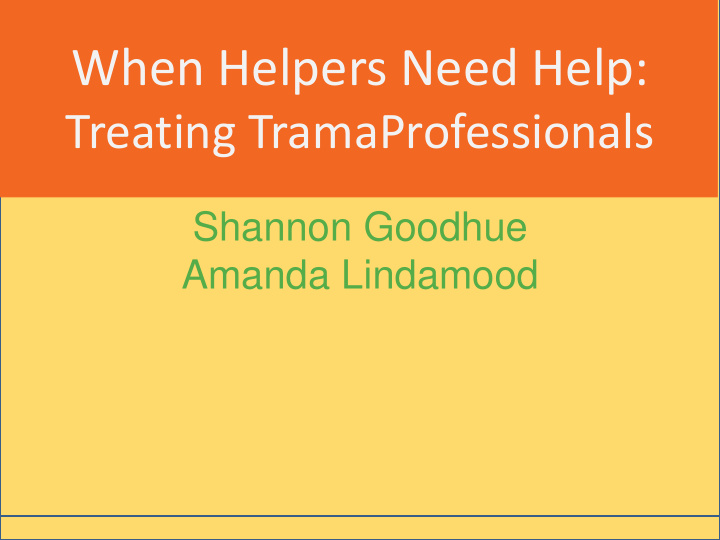



When Helpers Need Help: Treating TramaProfessionals Shannon Goodhue Amanda Lindamood
Treating Professionals Client fidgets, shifts, fidgets, paces, fidgets, “It must be so weird to see me in this state” Therapist: “not at all. This is actually really normal considering everything you are going through.” Client: matter of fact with a slight eye roll “ yeah. I know” pauses for a second, “I mean… no… thanks… I appreciate the normalizing.” Both laugh. Client: “Sorry, I cant help it!”
Step 1: Mutual Respect • Client often want to be respected as professional equals. Embrace it! – What does this do to the power dynamic? • Contain assumptions, labels, and judgements. • Have open discussions about your treatment styles, skill level, and favored techniques. Allow client to choose right path for themselves without judgement.
Risk, trust, and transparency • When a client enters a therapists office for the first time, what are they risking? • When a trauma professional enters a therapists office for the first time, are they taking additional risks? • When a trauma professional enters a therapists office, what is at risk for the therapist?
Trust • Expect to be challenged • Don’t be afraid to say ‘I don’t know that technique/research/book etc ’ • Recognize vulnerabilities for client (in admitting that they don’t ‘have it all together) and for the therapist (this person can see behind the curtain) • Self monitor for fears/vulnerabilities (so you don’t panic and drop your client)
Boundaries • What boundaries do you typically set with clients? – Time, personal information, focus of therapy, • Do they change with other professionals? Should they?
Use of Self • Professionals tend to demand that you are more present and ‘real’ • Often want to be engaged as professionals and as clients at the same time or alternatingly • Often want to know more about you professionally and personally
Use of Self Discussion: what are the ‘rules’ about self disclosure? – What are the dangers of renegotiating them? – What are the dangers of refusing to?
Assessment • Can feel like a ‘consult’ – clients often have strong opinions regarding their diagnosis and tx planning • Usually far more collaborative • Beware of client self monitoring, can be an opportunity to create safety • Balance respect for clients opinion with the professional urge to intellectualize and detach
Dual Relationships • Likely to happen in small communities, even small communities in big cities (such as SA or DV) • Demand discussion, collaboration, and constant revisiting • Boundaries should be mutually decided upon with safety for both parties involved in discussion
SELF-CARE
• What is ‘self - care’?
Shannon’s self care • Have a clear job description, and stick with it. • Get clear expectations from supervisor, including understanding definition of ‘success’ and ‘failure’ for the job • Go home at a reasonable hour. • Rarely work from home. • Give family and friends my full attention when with them.
Shannon’s self care plan • Say no when I need to say no • Remember that my clients and my job survived without me • Do things that engage a completely selfish, non empathetic side of myself • Spend time alone • Remember that my energy is finite • If the job will not allow me to do these things, I quit
Recommend
More recommend